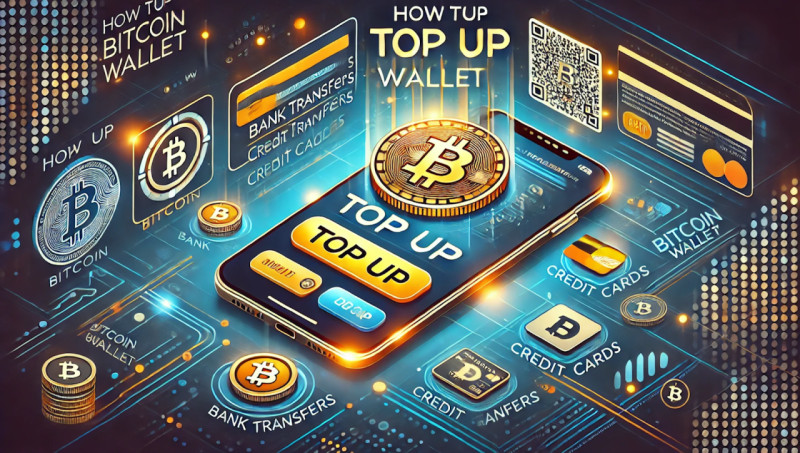
Mastering how to top up bitcoin wallet is an essential step in unlocking the full potential of this digital asset. A Bitcoin wallet acts as a secure vault, allowing users to manage and access their holdings efficiently. It serves as the primary interface for a wide range of activities, including trading, online purchases, and peer-to-peer exchanges. Without sufficient balance, fully utilizing the capabilities of Bitcoin becomes significantly more challenging.
Funding your wallet is not merely a technical requirement but a critical part of engaging with Bitcoin’s ecosystem. Adding value enables functionality, enhances versatility, and provides the flexibility needed to take advantage of opportunities in the digital economy. Whether you are an investor aiming to capitalize on market trends, a business accepting payments, or an individual looking to send funds across borders, having a properly funded wallet is the first and most crucial step.
Why Adding Funds Matters
1. Financial Independence
Bitcoin offers a unique opportunity to control your wealth independently of traditional banking systems. Unlike conventional accounts that rely on centralized authorities, Bitcoin empowers users to transact globally, keep value securely, and bypass restrictions often imposed by intermediaries. Adding funds unlocks this autonomy, providing access to a decentralized financial system that operates beyond geographic and institutional boundaries.
2. Supporting Essential Activities
- Investments: traders and long-term holders rely on a funded wallet to buy, sell, or hold Bitcoin effectively. The ability to respond quickly to market changes depends on having accessible reserves.
- Payments: spending Bitcoin on goods or services, whether online or in physical stores, requires readily available funds. Many merchants now accept Bitcoin as payment, further expanding its usability.
- Peer-to-peer transfers: sending funds to individuals anywhere in the world, often within minutes, is one of Bitcoin’s most compelling features. This level of accessibility is only possible with an adequately funded wallet.
3. Avoiding Barriers
Maintaining a sufficient balance prevents delays caused by insufficient funds or the need to add value during urgent situations. For traders, these delays can mean missed opportunities, while for casual users, they can lead to inconvenient disruptions. Keeping your wallet adequately funded ensures smooth and seamless exchanges, particularly in time-sensitive scenarios.
Methods for Adding Bitcoin
Purchasing from exchanges. Exchanges like Coinbase, Binance, and Kraken provide an easy way to acquire Bitcoin using traditional payment methods, such as bank transfers or credit cards. These platforms cater to a wide range of users, from beginners to experienced traders. Once purchased, Bitcoin can be moved to secure storage, ensuring better control and protection.
Peer-to-peer platforms. Platforms such as Paxful and LocalBitcoins let users trade directly with others. This method is particularly useful for those seeking privacy or flexibility, as it enables buyers and sellers to negotiate terms and payment options.
Bitcoin ATMs. Bitcoin ATMs offer a simple way to acquire Bitcoin using cash deposits. These machines are ideal for users who prefer offline methods or need quick access to funds. By scanning a QR code, users can send Bitcoin directly to their address, making the process fast and convenient.
Earning Bitcoin. Freelancers, businesses, and online sellers can accept Bitcoin as payment for services or products. Generating a public address lets customers send funds directly, providing an additional income stream without relying on exchanges or ATMs.
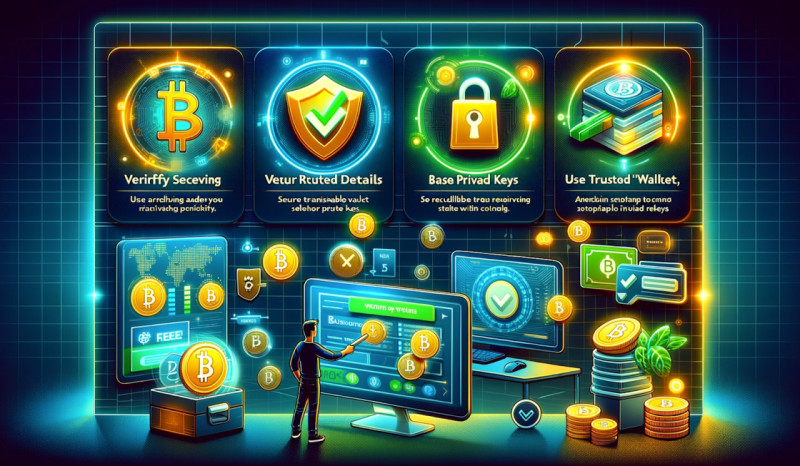
Security Best Practices
Verify receiving details. Double-check receiving addresses ahead of initiating a payment if you want to master how to top up bitcoin wallet. Even minor errors can result in the permanent loss of funds. Using QR codes or copy-paste functions can help eliminate the risk of manual mistakes.
Back up keys. Private keys or recovery phrases should be kept securely in multiple locations. Options such as fireproof safes, encrypted USB drives, or offline devices offer the best protection against loss or theft.
Use trusted services. Always choose platforms with strong reputations when purchasing or accepting Bitcoin. This reduces exposure to fraud and ensures smoother transactions.
Monitor costs. Network fees can vary significantly based on congestion. Planning ahead and initiating exchanges during low-demand periods helps minimize unnecessary expenses.
Benefits of Mastery
- Save on costs. Understanding the methods and timing of funding lets users minimize fees and optimize efficiency. This ensures more of the value being added remains within the wallet.
- Confidence in usage. By mastering the process, users gain confidence in their ability to manage Bitcoin effectively. Familiarity with the steps reduces anxiety and increases proficiency.
- Enhanced control. Maintaining a sufficient balance provides readiness for a wide range of activities, from spontaneous exchanges to investment opportunities. Control over your funds ensures you can act decisively without delays.
This guide comprehensively outlines the methods, strategies, and precautions necessary for mastering the process of adding cryptocurrency to your wallet. By following these principles, users can make informed decisions, safeguard their holdings, and confidently engage with the Bitcoin ecosystem, ensuring a smooth and secure experience at every step.
Understanding Bitcoin Wallets
What is a Bitcoin Wallet?
A crypto wallet is the fundament for managing digital assets, acting as the interface that lets users interact with their Bitcoin holdings. Unlike physical wallets that store cash, a Bitcoin wallet secures the cryptographic keys needed to access, verify ownership of, and manage balances on the blockchain. Mastering how to add digital assets to your storage begins with understanding these instruments and their critical role in the ecosystem.
The wallet itself does not hold Bitcoin. Instead, it secures two keys — public and private — that are essential for managing funds. Public keys function as receiving addresses, while private keys are the means to prove ownership and authorize payments. Together, they create a secure system that enables users to send, receive, and keep assets efficiently.
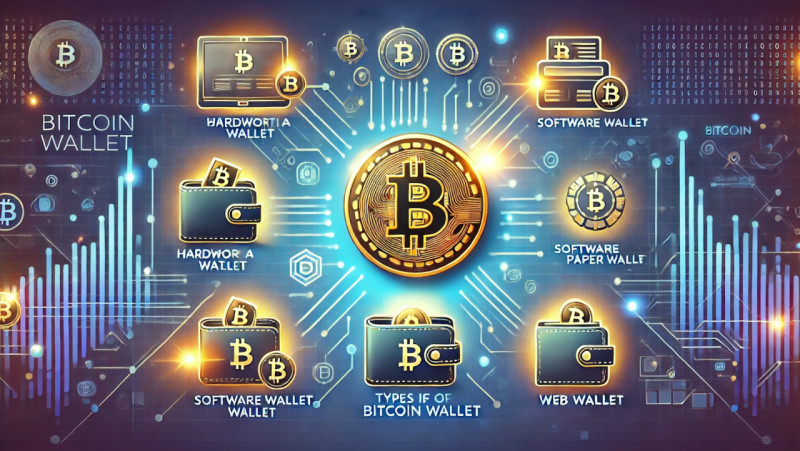
Types of Bitcoin Wallets
Bitcoin wallets come in various forms to meet the diverse needs of users. Selecting the appropriate type depends on factors like security preferences, usage frequency, and the value of holdings.
Hot storage:
- Always connected to the internet, these are suitable for users requiring frequent access.
- Includes mobile applications, desktop software, and web-based platforms.
- Known for convenience and speed, they are preferred by traders and those making frequent payments.
- More vulnerable to online threats such as hacking, malware, and phishing.
Cold storage:
- Offline solutions like hardware devices or paper backups prioritize maximum security.
- Ideal for users safeguarding large amounts or holding Bitcoin over the long term.
- Hardware wallets such as Trezor and Ledger ensure private keys remain offline, reducing exposure to cyber risks.
- Paper keys, while secure from online threats, require careful physical storage for avoiding damage or loss.
Choosing between hot and cold storage depends on individual priorities. Active users often prefer the accessibility of hot wallets, while long-term holders prioritize the security offered by cold storage when they want to learn how to top up bitcoin wallet.
Public and Private Keys: A Quick Overview
At the core of any Bitcoin wallet’s functionality are its cryptographic keys. These keys are essential for accessing funds and ensuring secure exchanges on the blockchain.
| Public key | Private key |
| Acts as a receiving address, letting others send Bitcoin securely | A unique key required to sign and authorize spending, proving ownership of the associated funds |
| Comparable to an account number, it can be shared freely without compromising security | Must remain confidential, as anyone with access can control the funds |
| Derived from the private key but plays no role in authorizing payments | Losing this key means permanent loss of access to the associated Bitcoin, making backups critical |
How Keys Interact with the Blockchain
Public and private keys work together to facilitate secure blockchain operations.
- Receiving Bitcoin: provide the public key to accept funds, whether from individuals, exchanges, or other sources.
- Spending Bitcoin: use the private key to sign and authorize outgoing payments, proving ownership of the funds being moved.
This system ensures only the rightful owner can authorize payments while enabling safe receipt of funds from others.
Security Best Practices
Ensuring the security of public and private keys is essential for protecting digital holdings. Mismanagement can result in unauthorized access, theft, or permanent loss.
Backup keys safely:
- Keep recovery phrases or private keys in multiple secure locations, such as fireproof safes, offline devices, or encrypted storage drives.
- Avoid relying on a single backup location to mitigate risks like physical damage or theft.
Limit online exposure:
- Never keep private keys or recovery phrases on cloud services or devices connected to the internet. These are vulnerable to breaches or hacking attempts.
- Use encrypted USB drives or offline devices for additional security.
Regularly update tools:
- Ensure software and hardware used for managing Bitcoin are updated frequently to incorporate the latest security patches and improvements.
Enable advanced security features:
- Use multi-factor authentication (MFA) for wallets that support it.
- Enable PIN protection or biometric access to added layers of defense.
Understanding Bitcoin wallets and the role of cryptographic keys empowers users to confidently navigate the digital landscape. Selecting the appropriate storage type and adhering to best practices minimizes risks while ensuring control over holdings. By mastering these fundamentals, users can securely manage their Bitcoin and optimize their interaction with the blockchain.
Preparing to Top Up
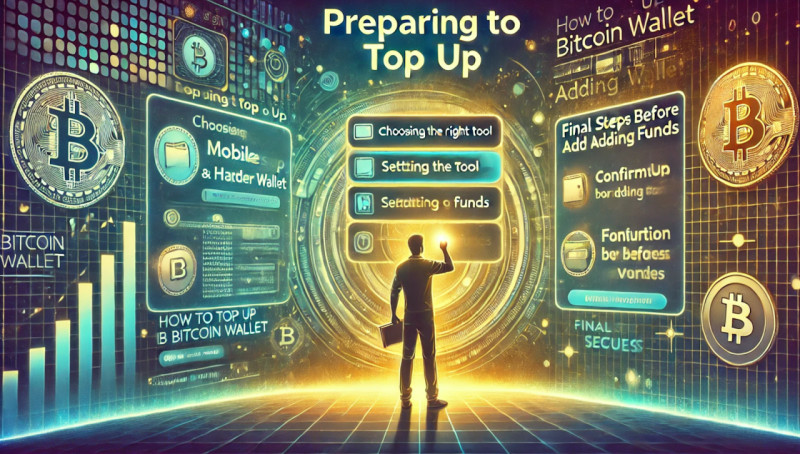
Choosing the Right Tool
Selecting the best option for managing digital assets is essential to ensure safety and ease of use. Your choice depends on whether you’re a casual user, an investor, or a frequent trader. Understanding key features and available options simplifies the process of how to top up bitcoin wallet effectively.
Key Features for consideration:
- Security: think of instruments with strong encryption, two-factor authentication, and backup capabilities. Hardware devices provide maximum protection from online threats.
- User-friendliness: beginners benefit from simple interfaces with clear instructions. Advanced users may prefer tools with customizable settings and additional features like smart contract support.
- Compatibility: ensure the tool supports the assets you plan to manage and integrates smoothly with exchanges or payment services.
Popular options:
- Hardware devices (e.g., Ledger, Trezor): perfect for long-term storage and larger amounts. These physical devices keep keys offline, offering strong protection against cyber risks.
- Mobile and software apps (e.g., Trust Wallet, Exodus): great for on-the-go access and smaller amounts. These options balance convenience with functionality for frequent use.
- Web-based platforms (e.g., Coinbase, Binance): ideal for those regularly buying or trading. While convenient, these platforms are more exposed to online vulnerabilities, so strong account security is vital.
Matching options to your needs:
- Regular use: mobile apps and web platforms offer fast access and intuitive interfaces.
- Long-term storage: hardware devices or paper backups provide unmatched security, ideal for safeguarding large balances.
Setting Up for Adding Funds
Proper configuration is critical ahead of adding value to your account. Skipping key steps can result in errors or vulnerabilities, making careful preparation essential.
Connecting to the network:
- Ensure your chosen tool is connected to the blockchain. Without this connection, it cannot receive or send funds.
- Many instruments sync automatically, but it’s worth confirming during setup.
Verifying receiving addresses:
- Each tool generates a unique receiving address. Always double-check this alphanumeric string ahead of sharing or using it for deposits.
- To reduce errors, use QR codes whenever possible.
Backing up keys:
- During setup, you’ll receive a recovery phrase or private key. Write it down and keep it securely in multiple safe locations, such as encrypted devices or fireproof safes.
- Test backups by restoring access to a test account to ensure recovery works.
Customizing security:
- Enable two-factor authentication (2FA) for an extra layer of safety.
- Create a strong, unique password and avoid reusing credentials across platforms.
Avoiding Common Mistakes
- Overlooking compatibility. Verify that your tool supports Bitcoin. While most do, some are limited to specific digital assets.
- Ignoring backups. Losing private keys or recovery phrases results in permanent loss of funds. Treat backups as essential.
- Rushing configuration. Take time to complete setup carefully, ensuring no critical steps are missed.
Final Steps Before Adding Value
After setup, familiarize yourself with the tool’s interface. Explore how to view balances, access addresses, and manage security settings. Properly configured instruments reduce errors and provide confidence during the funding process.
By selecting the right solution and following these steps, you ensure secure and seamless management of digital assets. Thoughtful preparation lays the groundwork for confidently adding value, managing holdings, and unlocking Bitcoin’s full potential.
Methods to Add Bitcoin
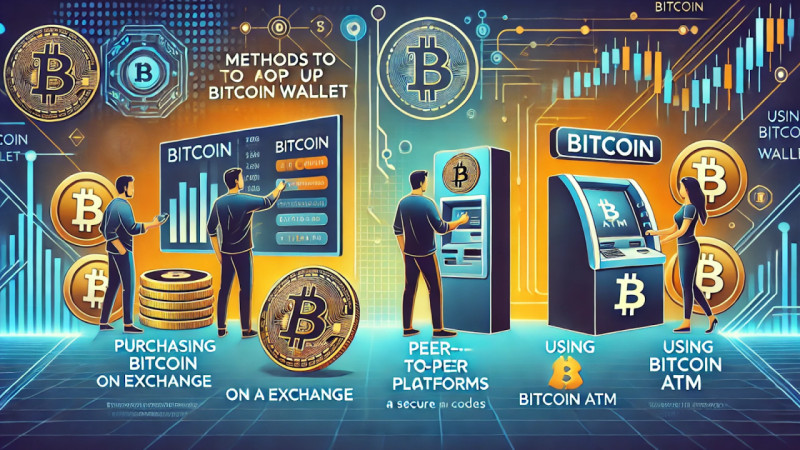
Purchasing Bitcoin on an Exchange
Exchanges are widely used platforms to acquire Bitcoin. They serve as centralized hubs where users can convert traditional money into digital assets. Offering a range of payment methods such as bank transfers, debit cards, and online payment services, exchanges serve diverse preferences for those who need to know how to top up bitcoin wallet.
Step-by-step guide:
- Create an account: register on a reputable platform like Coinbase, Binance, or Kraken. Complete any required verification, often involving submission of identity documents.
Deposit funds: add money using a linked bank account, card, or other accepted methods. Some platforms also accept regional payment options for added convenience.
Select Bitcoin: access the trading or market section, choose Bitcoin, and specify the amount you wish to purchase.
Confirm purchase: review all details, including exchange rates and fees, ahead of finalizing the purchase.
Withdraw funds: send Bitcoin to secure storage by providing your receiving address.
Exchanges are known for high liquidity, allowing users to trade large volumes without significantly impacting market prices. Features like price charts and real-time data empower users to make well-informed decisions.
Advantages of exchanges:
- Access to a variety of payment methods.
- Transparent pricing with live market rates.
- Built-in instruments to monitor purchases and performance.
Security tips:
- Enable two-factor authentication (2FA) to strengthen account security.
- Avoid keeping Bitcoin on exchanges for extended periods; transfer it to secure storage.
Peer-to-Peer Platforms
Buying directly from other individuals through peer-to-peer (P2P) platforms offers privacy and flexibility. These services connect buyers and sellers, enabling negotiation without intermediaries.
Steps for peer-to-peer trading:
Choose a platform: platforms like Paxful, LocalBitcoins, or Bisq provide secure environments for P2P exchanges.
Find a seller: browse listings to locate sellers offering favorable rates and payment options.
Initiate trade: negotiate terms and confirm payment methods. Most platforms use escrow services to hold funds securely until the trade is complete.
Verify receipt: ensure Bitcoin has been transferred to your balance before releasing payment.
P2P platforms often require less stringent verification than exchanges, making them useful in regions with limited access to centralized services.
Ensuring safety:
- Use platforms with robust escrow systems to minimize risk.
- Check seller reviews and ratings ahead of starting a trade.
- Avoid communicating or paying outside the platform to reduce fraud risks.
Using Bitcoin ATMs
Bitcoin ATMs provide an easy way to acquire Bitcoin using cash or debit cards. Found in many urban areas, these machines let users purchase Bitcoin without needing an online account.
Steps for using Bitcoin ATMs:
Locate an ATM: use instruments like CoinATMRadar to find a nearby machine.
Follow instructions: most machines require users to scan a receiving address (via QR code) or enter it manually.
Insert payment: deposit cash or use a card for completing the purchase.
Confirm details: double-check the amount and address ahead of finalizing the process.
Bitcoin is sent directly to the specified address once the purchase is complete. While convenient, Bitcoin ATMs often charge higher fees compared to other methods.
Advantages:
- No need to create an online account.
- Immediate transfer of funds.
Considerations:
- Verify fees beforehand, as they can vary widely.
- Ensure the address entered is correct, as mistakes cannot be undone.
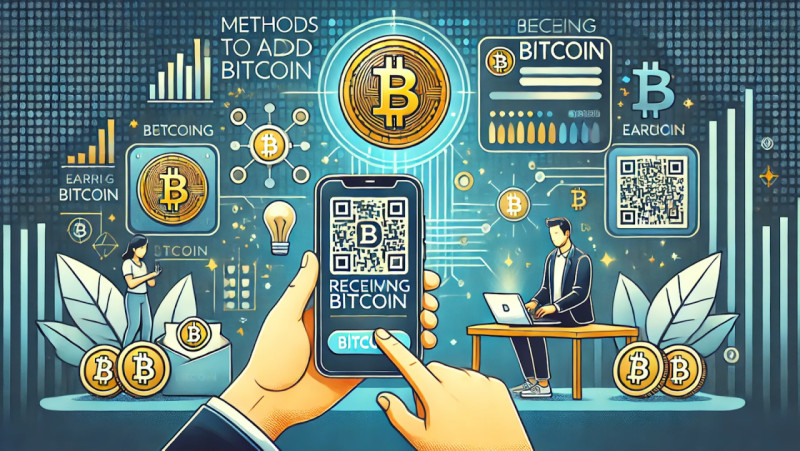
Receiving Bitcoin
Friends, family, or colleagues can send Bitcoin directly. This method requires only a receiving address, making it straightforward and secure.
Steps to receive Bitcoin:
Generate address: create a receiving address from your storage tool, usually a long alphanumeric string with an optional QR code for convenience for those who learn how to top up bitcoin wallet.
Share address: provide this to the sender, ensuring accuracy.
Monitor receipt: track the payment using a blockchain explorer or your storage tool.
Accuracy tips:
- Always double-check the address ahead of sharing. A single incorrect character can result in lost funds.
- Use QR codes for minimizing manual errors.
Receiving Bitcoin from a trusted source eliminates intermediaries, making it one of the simplest ways to add value.
Earning Bitcoin
Accepting Bitcoin as payment is a proactive method to grow your balance. Freelancers, businesses, and service providers can generate income without purchasing Bitcoin directly.
Ways to earn Bitcoin:
- Freelancing platforms: join sites like Bitwage or Cryptogrind to receive payment in Bitcoin for completed tasks.
- Selling goods or services: offer products or services that accept Bitcoin. Display your address or QR code for streamline payments.
- Affiliate programs: promote products or services from companies offering Bitcoin commissions.
Benefits of earning Bitcoin:
- Avoids purchasing fees.
- Provides consistent income, allowing dollar-cost averaging over time.
Best practices:
- Maintain a professional setup for invoicing and accepting payments.
- Use secure instruments for monitoring incoming funds.
These methods provide diverse and secure ways to manage the process of adding cryptocurrency to your wallet. Whether using exchanges, engaging in P2P trades, or earning directly, each approach empowers users to control their holdings effectively.
Transaction Fees and Confirmation Times

Understanding Fees
Fees are a crucial element of the blockchain network, designed to incentivize miners to validate and include payments in the blockchain. These costs are dynamic, fluctuating based on network traffic and the data size of each payment. When demand is high, fees rise as users compete to have their payments processed faster. Understanding fee structures is essential to mastering how to add digital assets to your storage efficiently and cost-effectively.
Factors influencing fees:
- Network congestion: high traffic leads to increased fees as competition for limited block space intensifies.
- Data size: payments with larger data footprints — due to multiple inputs or outputs — consume more space on the blockchain, resulting in higher costs.
- Priority for speed: payments requiring quicker processing need higher fees to incentivize miners to prioritize them.
Fee categories:
- Low priority: ideal for non-urgent payments that can wait until network traffic decreases.
- Medium priority: balances speed and cost, fitting everyday needs.
- High priority: recommended for time-sensitive activities like trades, where delays could result in missed opportunities.
Optimizing Fee Selection
Making informed choices about fees can significantly reduce costs while ensuring timely confirmations. Fee estimators and manual adjustments are tools that can help achieve the right balance.
Helpful tips:
Use fee estimators: platforms like mempool.space or integrated calculators within storage instruments provide real-time suggestions for optimal fees based on network conditions.
Manual adjustments: for experienced users, manually setting fees allows precise control, particularly during low-demand periods when reduced costs are achievable.
Batch payments: combining multiple payments into one minimizes the data footprint, lowering the cost per action.
Time your payments: sending during off-peak times, such as weekends or late at night, can significantly reduce fees due to lower network activity.
Understanding Confirmation Times
The blockchain processes payments in blocks, with each block taking about 10 minutes to confirm. However, actual confirmation times vary based on network load and the fee paid by those who want to master how to top up bitcoin wallet.
Key points:
- Faster payments: higher fees often secure placement in the next block, with confirmations typically taking around 10 minutes.
- Delays: payments with low fees may face extended delays, ranging from several hours to, in extreme cases, days during congestion.
- Completion threshold: most platforms consider payments fully processed after six confirmations, equating to roughly one hour. Smaller amounts may require fewer confirmations, depending on the recipient’s policies.
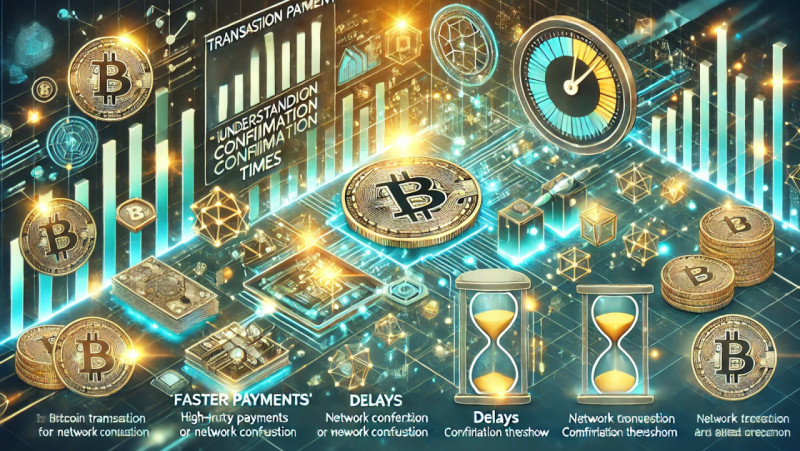
Tracking Progress
Blockchain explorers are essential instruments for monitoring the status of payments. These services provide real-time updates, enabling users to verify the progress of pending or completed actions.
How to use a blockchain explorer:
Locate the payment ID or receiving address.
Enter this information into an explorer like Blockchair or BTCScan.
Review details such as the number of confirmations, current status, and fees paid.
Benefits of tracking:
- Ensures transparency, giving users confidence in the process.
- Identifies potential issues, such as delays caused by insufficient fees or network congestion.
Resolving delays:
- Transaction accelerators: services like ViaBTC can expedite unconfirmed payments for a small fee or other criteria.
- Rebroadcasting payments: re-sending a pending action can improve its chances of inclusion in an upcoming block.
Best Practices for Efficient Fee Management
- Stay updated: monitor network activity through real-time analytics instruments. This helps you identify periods of low demand when fees are reduced.
- Be strategic: avoid paying excessive fees by carefully evaluating the urgency of each payment.
- Use technology: leverage features like fee optimization tools or transaction batching to save costs.
Efficient fee management and a clear understanding of confirmation times are critical for seamless Bitcoin usage. With real-time tracking tools, smart timing, and strategic fee selection, users can manage digital funds effectively, ensuring secure and cost-efficient processes.
Common Issues and Troubleshooting
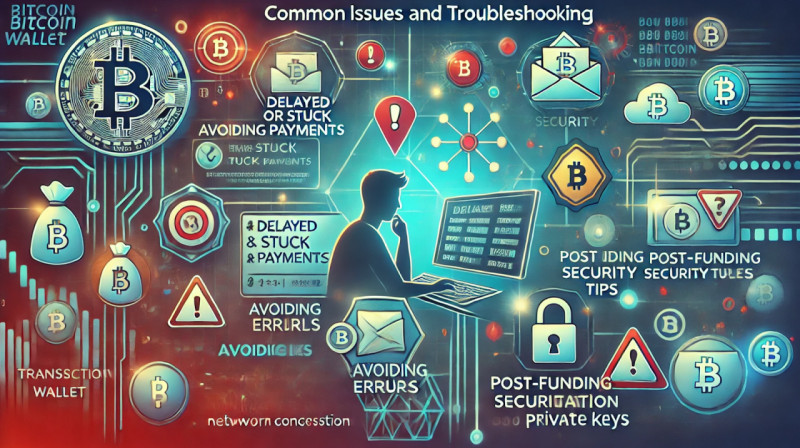
Delayed or Stuck Payments
A frequent challenge when managing funds is encountering delays or seeing payments appear unconfirmed. These issues often arise from network congestion or insufficient fees.
Causes of delays:
- Low fees: payments with minimal fees may not attract miners' attention, especially during high activity periods.
- Heavy traffic: increased usage can create backlogs, leading to delays even for payments with moderate fees.
- Complex data: payments using multiple inputs (e.g., combining funds from different addresses) require more space and take longer to process.
Solutions for delayed payments:
- Increase fees: some platforms support fee bumping instruments like Replace-By-Fee (RBF) or child-pays-for-parent (CPFP) to expedite unconfirmed payments.
- Transaction accelerators: services like ViaBTC allow users to prioritize pending payments for a small fee or in exchange for certain criteria.
- Wait it out: in less urgent cases, waiting for network traffic to decrease often resolves delays.
Prevention tips:
- Use real-time fee estimators to ensure appropriate costs ahead of sending funds.
- Choose platforms that offer customizable fee settings for greater control over payment processing.
Avoiding Errors
Payments on the blockchain are irreversible. Mistakes such as entering an incorrect address or sending the wrong amount can result in permanent losses. Attention to detail is critical for preventing errors for those who want to learn how to top up bitcoin wallet.
Address verification:
- Always copy-paste addresses instead of typing them manually to avoid mistakes.
- Verify the first and last few characters of the address after pasting to ensure accuracy.
Confirm amounts:
- Double-check the value being sent, especially when converting between digital assets and fiat currencies, as rates fluctuate.
- Ensure that fees are accounted for so the recipient receives the intended amount.
Backing up keys and recovery phrases:
- Losing private keys or recovery phrases means losing access to funds permanently.
- Store backups in multiple secure locations, such as encrypted USB drives, fireproof safes, or safety deposit boxes.
- Avoid keeping sensitive data in cloud services, which are vulnerable to breaches.
Security Concerns
The decentralized nature of blockchain transactions requires users to remain vigilant against risks such as phishing scams or counterfeit instruments.
Recognizing phishing attempts:
- Be cautious of unsolicited messages or emails requesting private keys or recovery phrases. Legitimate services will never ask for these details.
- Always confirm website URLs ahead of entering sensitive data. Scammers often replicate trusted platforms to trick users.
Avoiding counterfeit tools:
- Only download software from official sources or verified app stores.
- Research the reputation of services and tools through reviews or forums ahead of using them.
Best practices for safety:
- Enable two-factor authentication (2FA) for an additional layer of protection.
- Regularly update software to address security vulnerabilities.
- Use strong, unique passwords for accounts related to digital asset management.
Post-Funding Security Tips
Once your balance is funded, adopt proactive measures to maintain security:
- Regularly monitor balances and activity for detecting unauthorized access early.
- For long-term holdings, consider offline solutions like cold storage to reduce exposure to online threats.
Addressing delays, avoiding errors, and strengthening security measures empower users to confidently manage their digital holdings. Preparation and awareness are essential for a smooth experience and the effective protection of assets.
Advanced Tips for Efficient Top-Ups

Using Layer-2 Solutions
The Lightning Network is a secondary protocol designed to make transactions faster and less expensive. By enabling off-chain processing, it addresses challenges like slow speeds and high costs during peak network activity. Most actions are handled outside the main blockchain, with only final balances settled on-chain.
How it works:
- Opening channels: users create and fund off-chain channels that serve as private pathways for transferring value.
- Processing transactions: once a channel is open, nearly instant exchanges occur without needing on-chain confirmation.
- Closing channels: at the end of a session or when users no longer need the channel, the net result of all activity is finalized on the main blockchain.
Benefits of lightning:
- Speed: payments process almost immediately, eliminating delays common with on-chain actions.
- Cost savings: fees are significantly lower, even when the blockchain is congested.
- Microtransactions: allows very small transfers, which are impractical with traditional methods due to high fees.
Setting up lightning:
Choose a compatible instrument, such as BlueWallet or Phoenix, that supports Lightning.
Open a channel and fund it with Bitcoin from your primary balance.
Use the channel for frequent, low-cost transfers.
When to use lightning:
- Ideal for small purchases, frequent transfers, or microtransactions.
- Useful for reducing expenses during periods of high network congestion.
Scheduling Regular Top-Ups
Dollar-cost averaging (DCA) simplifies consistent purchases by automating the process of how to top up bitcoin wallet at regular intervals, regardless of price. This strategy spreads investments over time, minimizing the impact of market volatility.
How DCA works:
Select a platform offering recurring purchase features.
Choose a fixed amount to invest and set intervals (daily, weekly, or monthly).
Purchases occur automatically, with funds added to your balance for storage or withdrawal.
Benefits of automation:
- Consistency: builds holdings steadily without the need for manual intervention.
- Stress reduction: removes emotional decisions tied to price fluctuations, focusing on long-term growth.
- Convenience: automation reduces effort while maintaining a consistent strategy.
Recommended platforms:
- Coinbase: supports recurring buys linked to bank accounts for easy setup.
- Binance and Kraken: offer flexible subscription plans for regular investments.
Advanced tip: configure automatic withdrawals once your balance on the exchange reaches a specific threshold. This ensures secure transfer to offline or cold storage without manual effort.
Minimizing Fees
Keeping costs low is essential to maximize the value of your holdings. By evaluating options and optimizing strategies, fees can be significantly reduced.
Comparing methods:
- Exchanges: provide the lowest purchase fees but may charge for withdrawals. Research each platform’s fee structure ahead of choosing.
- Peer-to-peer platforms: direct trades often bypass traditional fees but depend on seller-specific terms.
- Bitcoin ATMs: convenient for quick access but typically associated with higher costs.
Timing transactions:
- Keep track of network congestion and aim to send payments during low-activity periods, such as weekends or late evenings, when fees are generally lower.
- Plan large transactions during these times to avoid high costs.
Batching payments:
- Combine multiple smaller transfers into a single larger action to reduce data size and minimize network fees.
Utilizing lightning for small payments:
- The Lightning Network is an excellent option for managing frequent or minor transactions without incurring high fees.
Seeking discounts:
- Some platforms offer reduced fees for high-volume users or those paying with native tokens, such as Binance Coin.
- Look for promotional periods where fees are temporarily lowered to encourage usage.
Creating a Streamlined System
Efficient management requires a balanced approach combining the right instruments, strategies, and timing. Incorporating layer-2 solutions, automating purchases through DCA, and reducing costs with batching or optimized timing ensures that your system remains adaptable and effective. With these methods, you can confidently navigate the process of adding cryptocurrency to your wallet while minimizing expenses and maximizing value.
Frequently Asked Questions (FAQs)
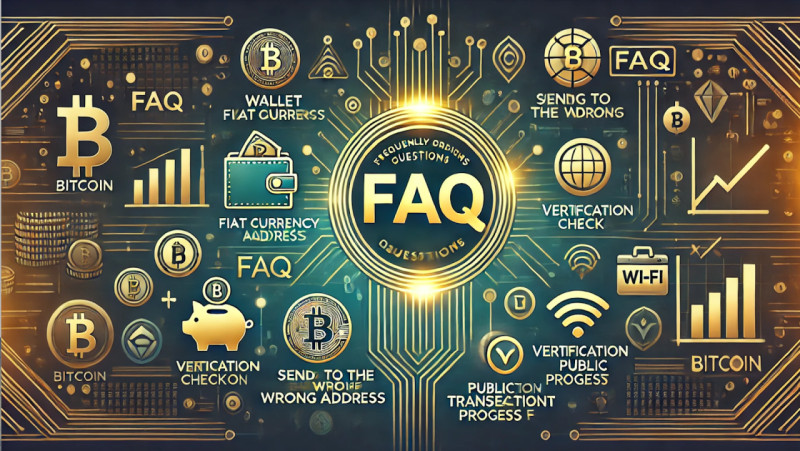
Can I top up my wallet with fiat currency directly?
Yes, many platforms allow direct funding using traditional money like dollars or euros. These services often accept payments via bank transfers, debit or credit cards, or online payment tools.
Platforms supporting direct purchases:
- Coinbase: Enables direct purchases using linked bank accounts or cards.
- Binance and Kraken: Provide fiat-to-Bitcoin conversion with flexible payment options.
- Local Payment Services: Some platforms integrate with regional providers for added accessibility.
Steps for funding with fiat:
- Register on a platform that supports fiat transactions.
- Complete identity verification if required.
- Deposit money using your preferred method.
- Convert the deposited amount into Bitcoin and send it to your storage.
Alternative methods:
- Bitcoin ATMs: Insert cash to receive Bitcoin directly.
- Peer-to-Peer Services: Buy Bitcoin from individuals using bank transfers or mobile payment apps if you want to master how to top up bitcoin wallet.
What happens if I send Bitcoin to the wrong address?
Sending Bitcoin to an incorrect address is irreversible due to the decentralized design of the network. No central authority can retrieve lost funds, but you can take steps to minimize risks.
Common causes of errors:
- Typing errors when manually entering long addresses.
- Copy-pasting mistakes, such as partial addresses or overwrites.
- Sending to incompatible or unsupported addresses.
Prevention tips:
- Always copy and paste addresses to avoid manual mistakes.
- Verify the first and last characters of the address after pasting.
- Use QR codes when possible for reducing input errors.
- Check compatibility ahead of sending to an exchange or service.
What to do if it happens:
- If the address belongs to someone you know, contact them immediately to request a return.
- If the funds went to an invalid or inactive address, they are likely unrecoverable.
How do I verify that the funds have been added?
Once a funding process is initiated, confirmations can be checked through blockchain instruments to ensure completion.
Steps for verification:
- Use a blockchain explorer like Blockchair or Mempool.
- Enter the payment ID or receiving address into the search bar.
- Review details such as confirmation count, amount received, and sender data.
Understanding confirmations:
- Payments are typically complete after six confirmations, meaning they have been added to six consecutive blocks.
- Smaller amounts may require fewer confirmations, depending on the platform.
Storage interfaces:
- Most tools update balances automatically once funds are received.
- If the balance does not update, use the blockchain explorer to verify the status.
Is it safe to use public Wi-Fi for transactions?
Public Wi-Fi is not secure and poses risks like hacking or data theft. Avoid using it to manage digital assets unless precautions are in place.
Risks of public networks:
- Hackers can intercept data sent over unprotected connections.
- Fake Wi-Fi hotspots may trick users into exposing sensitive information.
Steps to enhance security:
- Use a VPN for encrypting traffic.
- Avoid entering sensitive details or authorizing payments on public networks.
- Ensure websites or apps used are secured with HTTPS.
Safer options:
- Rely on a private and secure home connection to manage funds.
- Use mobile data for added security while on the move.
Understanding these FAQs equips users to manage digital assets with confidence. Following these precautions ensures a smooth experience, reducing the likelihood of errors and security issues.
Conclusion
Mastering how to add digital assets to your storage is an essential step toward controlling your digital wealth. Adding value to your balance unlocks opportunities for financial autonomy and participation in an evolving economy. Whether buying, trading, or holding for the long term, understanding the available methods and adopting best practices ensures a seamless and secure experience.
This guide has outlined various strategies for managing your balance effectively. From exchanges and peer-to-peer platforms to earning directly, the available methods cater to diverse needs and expertise levels. Each approach has unique advantages, and selecting the right one depends on your priorities — be it speed, privacy, or cost-effectiveness.
Knowing how to top up bitcoin wallet goes beyond a technical action; it represents an investment in financial freedom. By implementing the tools and techniques discussed here, you can confidently navigate the ecosystem and optimize your experience.
Recap of Methods for Adding Bitcoin
Purchasing through exchanges:
- Reliable and widely accessible, with multiple payment methods like bank transfers and cards.
- Automation instruments, such as dollar-cost averaging, simplify consistent accumulation.
Peer-to-peer platforms:
- Enable private trades with flexible terms.
- Escrow services ensure secure exchanges while allowing direct negotiation.
- Useful in regions with limited centralized services.
Bitcoin ATMs:
- Offer immediate access through cash or card payments.
- Best for simplicity and those preferring in-person interactions.
- Typically involve higher fees compared to other methods.
Accepting Bitcoin as payment:
- Allows earning directly by offering products or services.
- Freelancers, business owners, and creators can integrate Bitcoin into payment systems.
- Creates a steady income stream without requiring purchases.
Using the lightning network:
- Speeds up smaller payments and reduces costs.
- Ideal for frequent users or managing lower balances.
- Minimizes fees during high network congestion.
Encouragement to Choose Secure and Convenient Options
- Beginners:
Start with simple options like exchanges or ATMs to gain confidence. These methods are user-friendly and require little technical expertise.
- Privacy-focused users:
Peer-to-peer platforms offer flexibility and discretion. Choose services with strong escrow systems to mitigate risks.
- Long-term holders:
Automate regular purchases through exchanges to build balances steadily without worrying about market timing.
Your choice depends on your goals. Security, cost, and convenience are key factors to consider when selecting a method.
Best Practices for a Smooth Experience
Verify details. Always double-check receiving addresses and amounts ahead of proceeding. Mistakes here can result in permanent losses.
Time your actions. Use instruments to identify low-activity periods on the network. Planning ahead helps reduce fees and ensures faster processing.
Protect your keys. Keep private keys and recovery phrases offline in secure locations, such as encrypted drives or fireproof safes. Avoid saving them online.
Enhance security. Enable two-factor authentication for accounts and regularly update passwords. Ensure your tools and software remain up-to-date.
Stay informed. Keep track of updates and innovations in tools or platforms used to manage funds to maximize security and compatibility.
A Call to Action
Now is the time to take charge of your digital assets. Whether starting fresh or refining your approach, the strategies shared here provide a solid framework for success. Select a method that aligns with your goals, from automated purchases to earning directly, and pair it with strong security practices for protecting your holdings.
Adding value to your balance is not just about completing a process — it’s about embracing a pathway to financial independence. By understanding how to top up bitcoin wallet and applying this knowledge, you gain greater control over your digital wealth and unlock new opportunities. Equip yourself with these insights and take the next step in shaping your financial future. The moment to act is now.
















